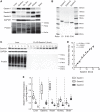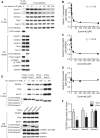Evidence for a role for Sestrin1 in mediating leucine-induced activation of mTORC1 in skeletal muscle
- PMID: 30835510
- PMCID: PMC6580170
- DOI: 10.1152/ajpendo.00522.2018
Evidence for a role for Sestrin1 in mediating leucine-induced activation of mTORC1 in skeletal muscle
Abstract
Previous studies established that leucine stimulates protein synthesis in skeletal muscle to the same extent as a complete mixture of amino acids, and the effect occurs through activation of the mechanistic target of rapamycin in complex 1 (mTORC1). Recent studies using cells in culture showed that the Sestrins bind leucine and are required for leucine-dependent activation of mTORC1. However, the role they play in mediating leucine-dependent activation of the kinase in vivo has been questioned because the dissociation constant of Sestrin2 for leucine is well below circulating and intramuscular levels of the amino acid. The goal of the present study was to compare expression of the Sestrins in skeletal muscle to other tissues and to assess their relative role in mediating activation of mTORC1 by leucine. The results show that the relative expression of the Sestrin proteins varies widely among tissues and that in skeletal muscle Sestrin1 expression is higher than Sestrin3, whereas Sestrin2 expression is markedly lower. Analysis of the dissociation constants of the Sestrins for leucine as assessed by leucine-induced dissociation of the Sestrin·GAP activity toward Rags 2 (GATOR2) complex revealed that Sestrin1 has the highest affinity for leucine and that Sestrin3 has the lowest affinity. In agreement with the dissociation constants calculated using cells in culture, oral leucine administration promotes disassembly of the Sestrin1·GATOR2 complex but not the Sestrin2 or Sestrin3·GATOR2 complex. Overall, the results presented herein are consistent with a model in which leucine-induced activation of mTORC1 in skeletal muscle in vivo occurs primarily through release of Sestrin1 from GATOR2.
Keywords: Sestrin; leucine; mTOR; skeletal muscle.
Conflict of interest statement
No conflicts of interest, financial or otherwise, are declared by the authors.
Figures







Similar articles
-
Effects of Leucine Ingestion and Contraction on the Sestrin/GATOR2 Pathway and mTORC1 Activation in Rat Fast-Twitch muscle.J Nutr. 2023 Aug;153(8):2228-2236. doi: 10.1016/j.tjnut.2023.06.011. Epub 2023 Jun 14. J Nutr. 2023. PMID: 37328110
-
The Sestrins interact with GATOR2 to negatively regulate the amino-acid-sensing pathway upstream of mTORC1.Cell Rep. 2014 Oct 9;9(1):1-8. doi: 10.1016/j.celrep.2014.09.014. Epub 2014 Sep 25. Cell Rep. 2014. PMID: 25263562 Free PMC article.
-
Differential regulation of mTORC1 activation by leucine and β-hydroxy-β-methylbutyrate in skeletal muscle of neonatal pigs.J Appl Physiol (1985). 2020 Feb 1;128(2):286-295. doi: 10.1152/japplphysiol.00332.2019. Epub 2020 Jan 16. J Appl Physiol (1985). 2020. PMID: 31944890 Free PMC article.
-
Sestrin regulation of TORC1: Is Sestrin a leucine sensor?Sci Signal. 2016 Jun 7;9(431):re5. doi: 10.1126/scisignal.aaf2885. Sci Signal. 2016. PMID: 27273098 Free PMC article. Review.
-
Locked in Structure: Sestrin and GATOR-A Billion-Year Marriage.Cells. 2024 Sep 21;13(18):1587. doi: 10.3390/cells13181587. Cells. 2024. PMID: 39329768 Free PMC article. Review.
Cited by
-
Sestrins' Expression in the Liver Is Not Altered by Short-Term Calorie Restriction in Young and Old Rats.Gerontology. 2022;68(7):790-798. doi: 10.1159/000521639. Epub 2022 Jan 27. Gerontology. 2022. PMID: 35086105 Free PMC article.
-
SEA and GATOR 10 Years Later.Cells. 2021 Oct 8;10(10):2689. doi: 10.3390/cells10102689. Cells. 2021. PMID: 34685669 Free PMC article. Review.
-
Glucose-Induced Activation of mTORC1 is Associated with Hexokinase2 Binding to Sestrins in HEK293T Cells.J Nutr. 2023 Apr;153(4):988-998. doi: 10.1016/j.tjnut.2022.11.021. Epub 2022 Dec 22. J Nutr. 2023. PMID: 37061344 Free PMC article.
-
Leucine ingestion promotes mTOR translocation to the periphery and enhances total and peripheral RPS6 phosphorylation in human skeletal muscle.Amino Acids. 2023 Feb;55(2):253-261. doi: 10.1007/s00726-022-03221-w. Epub 2022 Dec 6. Amino Acids. 2023. PMID: 36474017
-
Sestrin1, 2, and 3 are dispensable for female fertility in mice.J Ovarian Res. 2024 Feb 1;17(1):28. doi: 10.1186/s13048-024-01345-z. J Ovarian Res. 2024. PMID: 38297375 Free PMC article.
References
-
- Bar-Peled L, Chantranupong L, Cherniack AD, Chen WW, Ottina KA, Grabiner BC, Spear ED, Carter SL, Meyerson M, Sabatini DM. A Tumor suppressor complex with GAP activity for the Rag GTPases that signal amino acid sufficiency to mTORC1. Science 340: 1100–1106, 2013. doi:10.1126/science.1232044. - DOI - PMC - PubMed
Publication types
MeSH terms
Substances
Grants and funding
LinkOut - more resources
Full Text Sources
Research Materials
Miscellaneous

